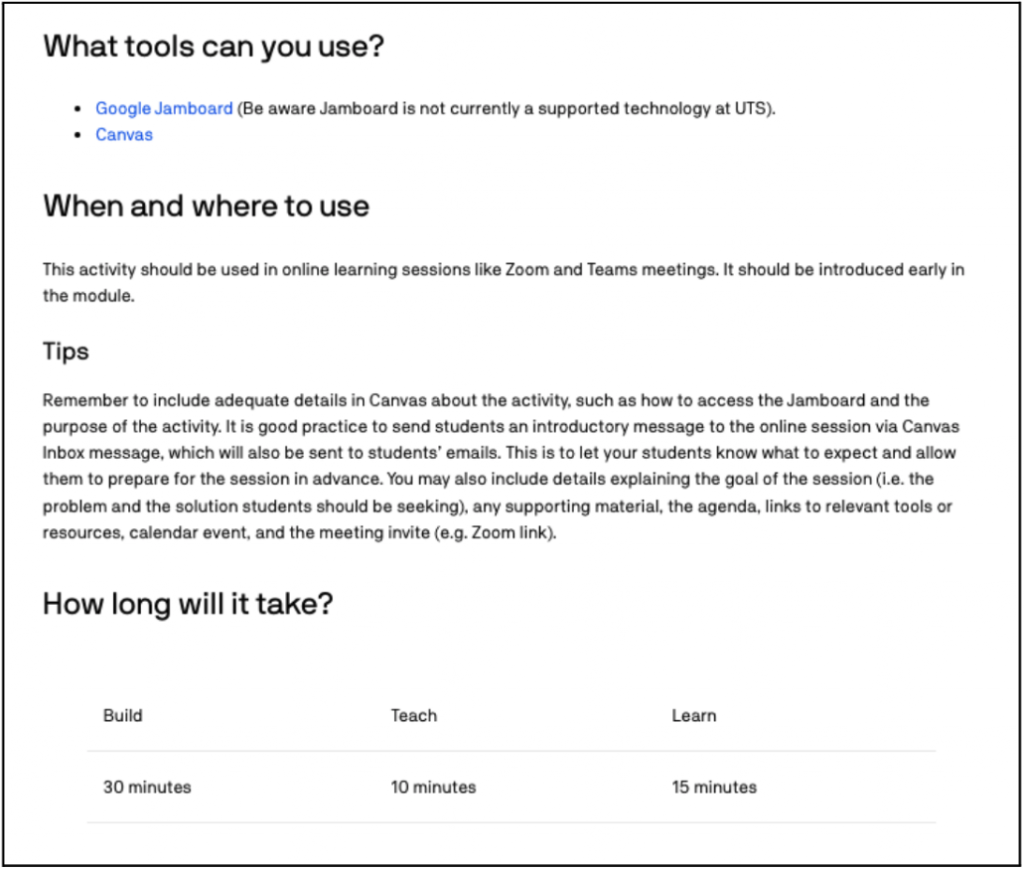Many academics develop their own teaching strategies over years, and evaluate and adjust their approaches to achieve anticipated outcomes. With your research methodology thinking hat on, this can be similar to formulating a hypothesis or a prototype (academic’s own pedagogy), conducting the experiment in real life settings (developing learning activities for students), observing and collecting data (students engagement and feedback) and then analysing findings to accept or negate the hypothesis or adjust the initial prototype (reflexive practice to refine their own pedagogy for following sessions).
While it’s clear that creative teaching practices are used across all UTS faculties, limited platforms are available for academics to share their refined and validated teaching practices with the wider community. We have a resource collection to make this process easier for all, whether you wish to share your own practices or learn from others.
The ‘Adaptable resources for teaching with technology’ collection
The Adaptable resources for teaching with technology collection was launched by the LX.lab in 2019, with learning designers, curriculum developers and academics worked on producing resources drawn from their teaching practices. In the LX.lab our endeavours are focused on enhancing the learning experience. In this collection we craft learning activities and assessments by focusing on three aspects; affordances of technology, evidence from teaching practices and underpinning learning theory.
Did you know?
All resources in the Adaptable resources for teaching with technology collection are provided as Open Educational Resources under Creative Commons Licence Attribution-NonCommercial-ShareAlike 4.0 International
This means that anyone can use, remix, tweak, and build on the resources in their own subjects or any other work. Keep in mind two things:
- Acknowledge the author(s) of the resources.
- You may not use the resources for commercial purposes.
How to use the resources
The collection consists of two sections: Learning and Teaching Activities and Assessments. Each resource is designed to be easily read. There is so much out there in published research about the use of technology in learning and teaching (e.g. ASCILITE conference, BJET journal…etc). But because we know that for academics the most valuable asset is time, we designed the resources so academics can make quick decisions by simply skimming the content to be able to decide how to adapt the activity into their own context.
The parameters in each resource provide quick information about:
- the objective of the activity
- when to introduce it
- size of the classroom
- tools required
- delivery mode
- how long it will take to build the activity and for students to engage with it (for the assessment resources, the resources also shows time required for marking).
Academics can easily decide how to use the instructional steps to implement the activity into their subjects.

Even though we try to make the resources short and snappy, the collection also draws on research findings and presents the underpinning learning theory that supports the design of the learning activities and assessments. Each resource provides the learning theory and research findings that support the design of the activities and assessment, followed by a list of references for further reading.

What academics told us about the collection
The collection offers a shortcut for academics to make informed decisions quickly and more effectively. All resources in this collection were drawn from lived experiences in teaching practice, and the generosity of the contributors is the main driver for sharing their own teaching practices.
For example, in the video below Amara Atif (Scholarly Teaching Fellow, School of Computer Science, Faculty of Engineering and Information Technology) talks about her experience generating Scaffolding as a teaching strategy while teaching 32557 Enabling Enterprise Information Systems in Autumn 2022. Amara commented that among many other benefits this approach has helped increase class engagement, created an opportunity for students to build stronger understanding towards the content and increased motivation as students become more proficient.
On the other hand, Anjali Gupta (Lecturer, School of Mathematical and Physical Sciences, Faculty of Science) reflected on her experience using Welcome to the subject resource in generating welcome videos in her subjects over the last two years, where she mentioned that:
I find the ‘Welcome to the subject’ resource helpful because it’s a very good reminder to me of all the things I need to talk about in that welcome video. Otherwise, I’ll be sitting down and thinking through the entire course that I need to talk to students about this, this and this. I like that the script template kind of touches on all the important points. For example, subject outline is there, assessment is there, how much effort is required from students is right there. So, it really shows all the important aspects.
Anjali Gupta
How can you be involved
If you are interested in sharing your teaching approach in the Adaptable resource for teaching with technology collection, please contact the LX.lab via lxlab@uts.edu.au.
We will arrange to meet with you to discuss your work, help you with converting your approach into an adaptable resource, and publish it via the LX site.
Learn more about the collection at our upcoming Tooltime
Our next Tooltime session will focus on the Adaptable resources for teaching with technology collection. You can register via the link below.
Image by Andy Roberts
